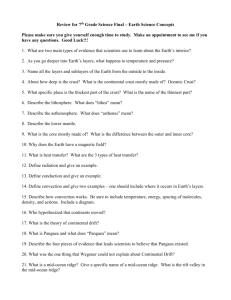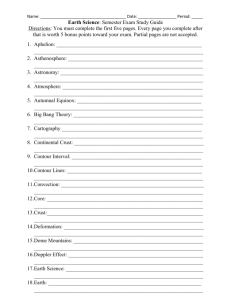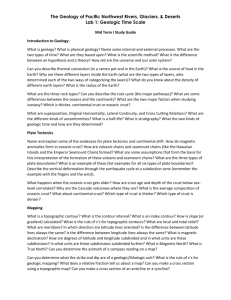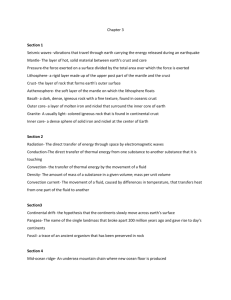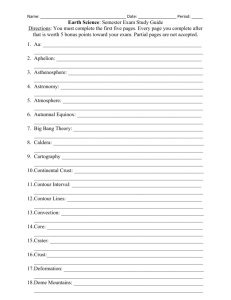STUDY GUIDE: CHAPTER 9 (PLATE TECTONICS)
advertisement
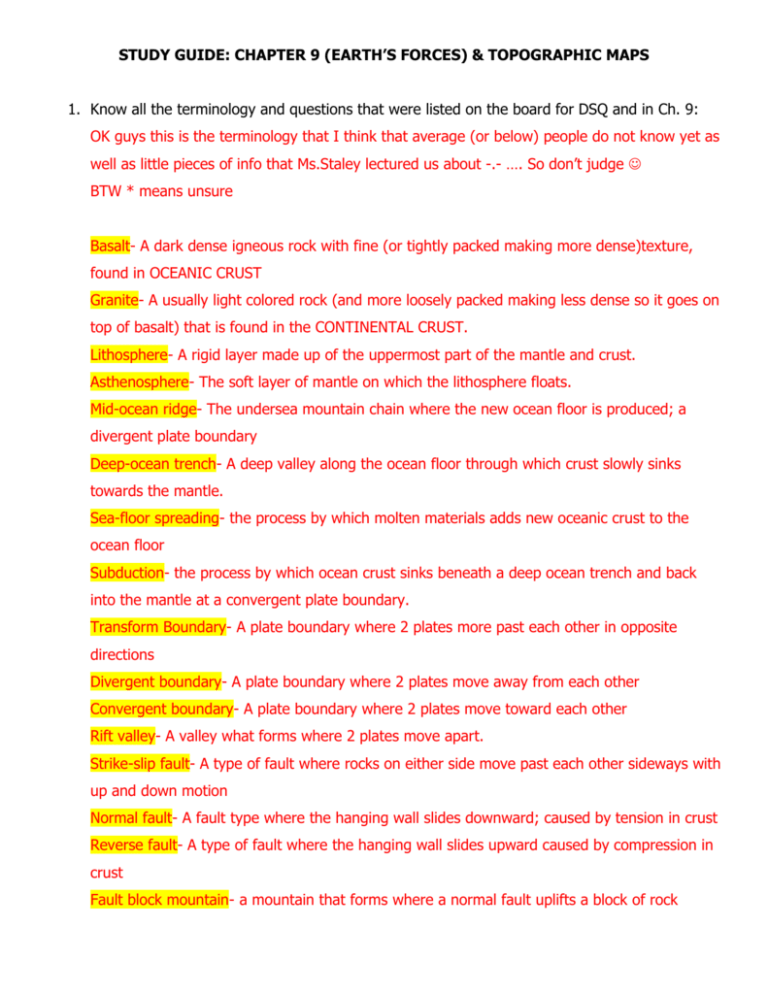
STUDY GUIDE: CHAPTER 9 (EARTH’S FORCES) & TOPOGRAPHIC MAPS 1. Know all the terminology and questions that were listed on the board for DSQ and in Ch. 9: OK guys this is the terminology that I think that average (or below) people do not know yet as well as little pieces of info that Ms.Staley lectured us about -.- …. So don’t judge BTW * means unsure Basalt- A dark dense igneous rock with fine (or tightly packed making more dense)texture, found in OCEANIC CRUST Granite- A usually light colored rock (and more loosely packed making less dense so it goes on top of basalt) that is found in the CONTINENTAL CRUST. Lithosphere- A rigid layer made up of the uppermost part of the mantle and crust. Asthenosphere- The soft layer of mantle on which the lithosphere floats. Mid-ocean ridge- The undersea mountain chain where the new ocean floor is produced; a divergent plate boundary Deep-ocean trench- A deep valley along the ocean floor through which crust slowly sinks towards the mantle. Sea-floor spreading- the process by which molten materials adds new oceanic crust to the ocean floor Subduction- the process by which ocean crust sinks beneath a deep ocean trench and back into the mantle at a convergent plate boundary. Transform Boundary- A plate boundary where 2 plates more past each other in opposite directions Divergent boundary- A plate boundary where 2 plates move away from each other Convergent boundary- A plate boundary where 2 plates move toward each other Rift valley- A valley what forms where 2 plates move apart. Strike-slip fault- A type of fault where rocks on either side move past each other sideways with up and down motion Normal fault- A fault type where the hanging wall slides downward; caused by tension in crust Reverse fault- A type of fault where the hanging wall slides upward caused by compression in crust Fault block mountain- a mountain that forms where a normal fault uplifts a block of rock Land subsidence- A sinking or subsiding of a land surface as a result or geological process or of human activities 2. How do geologists observe the earth’s interior? Seismic waves. These waves get a picture of how the earth is put together 3. The farther down into the earth, the Greater/higher the temperature and pressure becomes. 4. Oceanic crust is made up of rock called basalt , while continental crust is made up of rock called Granite . 5. If oceanic crust collides with continental crust, which one will sink? Why? Oceanic crust sinks because its denser. Basalt is more compacted than granite making it way denser leading it to sink while granite floats on top. 6. Which part of the core behaves like a thick liquid, as opposed to a dense ball of solid metal? The outer core. 7. Heat transfer by convection is caused by differences in density and temperature 8. Convection currents occur in what part (specifically) of the earth? Asthenosphere 9. Albert Wegener came up with the hypothesis that the continents have moved over time, having once been joined as a single land mass. 10. What is the name of the book he published in 1915 to support his ideas? The Origin of Continents and Oceans (According to some people I know, this year is on the test so don’t forget) 11. List and describe the 3 key pieces of evidence he used to support his ideas? Ancient climate similarities, Fossils, and similarity of rock structures. . 12. Did many geologists support his ideas at the time? Why/why not? Many scientists rejected the theory because he could not explain why or how the continents moved. Also it meant that they had to change their hypotheses. 13. The longest chain of mountains in the world is the 14. Henry Hess* Mid ocean ridge . proposed the idea of sea-floor spreading. 15. List and describe the 3 key pieces of evidence used to support sea-floor spreading. Drilling samples, magnetic stripes, molten material 16. The Pacific ocean is said to be shrinking because Atlantic ocean is said to be expanding because 17. J Tuzo Wilson* it has too little ridges it has too little trenches , while the . observed that there are cracks on the continents similar to those on the ocean floor. These cracks separate various sections of the lithosphere called tectonics . 18. Which type of boundary is most commonly associated with earthquakes? Transform Boundaries 19. Which type of boundary is most commonly associated with the formation of rift valleys? Divergent Boundaries 20. Which type of boundary is most commonly associated with the formation of mountains? Convergent Boundaries 21. Which types of crust must meet in order for subduction to occur? Oceanic and Continental crust 22. Which types of crust must meet in order for mountains to form? Continental Crusts (2) 23. Know the three types of faults. Know the direction of rock movement as well as the hanging and footwalls (when it applies), and identify the type of deformation (Stress) that creates the faults: Strike-slip fault- A type of fault where rocks on either side move past each other sideways with up and down motion Normal fault- A fault type where the hanging wall slides downward; caused by tension in crust Reverse fault- A type of fault where the hanging wall slides upward caused by compression in crust 24. Name and describe 2 ways in which mountains can form. Folding(Compression) and Faulting Fault Block(Tention) Ex. Appalachian mts and Grand Tentons in wyoming 25. What are the 2 key reasons for land subsidence? Geological process (at divergent boundaries; uplifting in one area= subsidence in adjoining area) Human Activity (Sinkholes from drilling= groundwater depletion) 26. What is the Ring of Fire?—Where is it located? The Ring of Fire is a result of subduction around the Pacific Plate. It is a ring of volcanoes. It is located on the border of the Pacific plate. 27. Name 2 hotspots that are a part of the United States, including which plate they are on. Yellowstone, North American Plate Hawaii, Pacific Plate 28. Be able to define the following terms related to topographic maps: Topography Contour line Contour interval Topography- The physical features of a region. Contour Line- connects points of equal elevation. Contour interval- The change in elevation from one contour line to the next 29. Know the following topographic maps concepts: a. The 4 key colors used on the maps and what each is used for 1) Blue- represent water features 2) Brown- represents contour lines 3) Green- woodlands 4) Black represents manmade works (solid lines for roads; dotted for trails) b. What happens to the shape of contour lines as the cross a stream or valley The line bends to form a “V” that points upstream or towards the valley c. The difference between a hill and a depression (physically and how they are represented on a map) A hill is an uplifted part of the earth while depressions is a lower section of the earth. The hill is represented by a countour line that forms a closed loop with no other contour lines in it. A depression is represented by contour lines that form a closed loop with dashes in the inside of it. d. How to differentiate between a gradually sloping hill and a very steep hill A gradually sloping hills have widely spread contour lines while closely spaced contour lines represent steeper slopes. e. How to find the contour interval even if you are not specifically given it on a map Every 5 contour lines has a number indicating what height that contour line is at. (its called contour line index) f. A key rule regarding contour lines that you should keep in mind when creating a topographic map Is to always have the contour interval. (Also keys should always have indications of the meanings of the colors on the map, variations in lines, and scale of the map)

